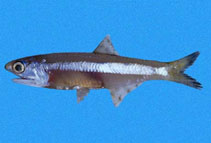| Family: |
Engraulidae (Anchovies), subfamily: Engraulinae |
| Max. size: |
17 cm TL (male/unsexed); max.weight: 26.9 g |
| Environment: |
pelagic-neritic; brackish; marine; depth range 0 - 142 m |
| Distribution: |
Eastern Pacific: San Juanico Bay, northern Gulf of California southward to Callao, Peru and perhaps further south. The record from Santa Margarita Island on the Pacific coast of Baja California, Mexico is based solely on the now lost type of Stolephorus cultratus. |
| Diagnosis: |
Dorsal spines (total): 0-0; Anal spines: 0-0; Anal soft rays: 20-25. Fairly elongate. Snout long, about 3/4 eye diameter or more; maxilla long, tip pointed, reaching almost to gill opening; gill cover canals of panamensis-type; pseudobranch longer than eye diameter, with 30 or more filaments, extending onto inner face of operculum. Anal fin origin under or just behind base of last dorsal fin ray. Silver stripe along flank about eye diameter. |
| Biology: |
A schooling species occurring in coastal waters, near shores, entering bays and tolerating some lowering of salinity. Spawns throughout the year, but more intensively in the warmer months. The eggs are oval. The most important tuna baitfish in Manta, Ecuador. |
| IUCN Red List Status: |
Least Concern (LC); Date assessed: 25 October 2019 Ref. (130435)
|
| Threat to humans: |
harmless |
Source and more info: www.fishbase.org. For personal, classroom, and other internal use only. Not for publication.
